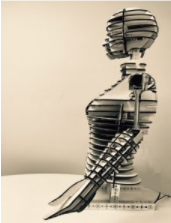 This week we’re spotlighting CityTech’s own “Roboquín”. In addition to being a seemingly futuristic mannequin robot fashion model that can interact with people via Bluetooth and Wifi connectivity, Roboquín is also a larger multidisciplinary project composed around the construction and showcasing of the mannequin robot (hereafter the robot will be referred to as RoboQueen and the project will be referred to as Roboquín). Though supervised by Professor Farrukh Zia of the Computer Engineering Technology department, this project is comprised of professors and students from a range of departments including Architecture, Mechanical Engineering, and Computer Science Technology. In this way, Roboquín is an excellent example of how OpenLab can facilitate cross-disciplinary communication and workflow.
This week we’re spotlighting CityTech’s own “Roboquín”. In addition to being a seemingly futuristic mannequin robot fashion model that can interact with people via Bluetooth and Wifi connectivity, Roboquín is also a larger multidisciplinary project composed around the construction and showcasing of the mannequin robot (hereafter the robot will be referred to as RoboQueen and the project will be referred to as Roboquín). Though supervised by Professor Farrukh Zia of the Computer Engineering Technology department, this project is comprised of professors and students from a range of departments including Architecture, Mechanical Engineering, and Computer Science Technology. In this way, Roboquín is an excellent example of how OpenLab can facilitate cross-disciplinary communication and workflow.
In addition to a description of the project and its members, the group uses their site for two purposes. First, they use the site to showcase ‘the travels’ of RoboQueen – from the 2016 World Marker Faire in Queens to CityTech’s own Annual Open House – and the visitors it has dazzled.
Second, Roboquín’s project site hosts images and information detailing the construction of RoboQueen, and includes links to resources that could be used by another team in the construction of their own ‘RoboQueen’. Beyond the potential for visitors of Roboquín’s site to replicate the designs, this information is emblematic of the kind of transparency OpenLab affords its users.
Together, these two qualities allude to another important affordance embedded in OpenLab’s infrastructure – the ability to archive information in a centralized, organized and chronological way. Beyond sharing information, archiving is a critical process in project development as it allows one to see where a project has been and envision where it might go in the future.



